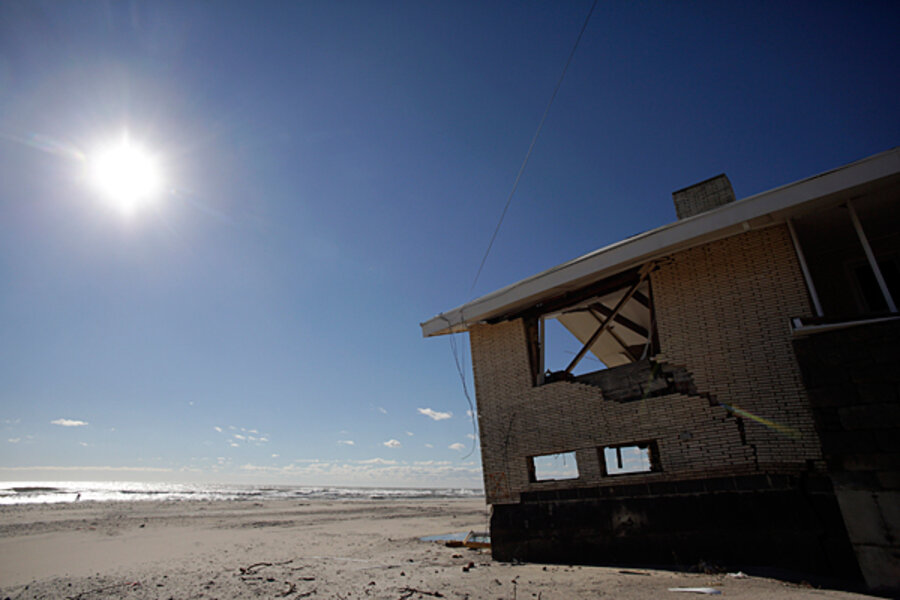Sandy aid: Home buyouts? Competitions for cash? Officials think bold.
Loading...
| New York
Federal dollars are beginning to flow to regions affected by superstorm Sandy, and proposals for spending that taxpayer-funded dough have ranged from the creative to the controversial.
Besides the necessary but dull mold remediation, roof repairs, and dredging of waterways, New York and New Jersey leaders are proposing “Race to the Top”-style competitions, aggressive tourism marketing campaigns, and contentious home buyouts, totaling in the hundreds of millions of dollars.
In play is $5.4 billion, the first installment of the nearly $51 billion Sandy aid package that Congress approved last month. Of that, New York City will receive $1.77 billion, New Jersey $1.82 billion, and New York State $1.71 billion, with the remaining funds split between Connecticut, Maryland, and Rhode Island.
The funds will be granted as Community Development Block Grants, the government’s version of a virtual blank check. Managed by the US Department of Housing and Urban Development, these grants are among the most direct ways for government to award aid money and provide local officials immense freedom and flexibility in spending funds. All plans require federal approval, with the first aid checks to arrive in late spring.
“It is up to them to decide what the most important needs are,” HUD Secretary Shaun Donovan said in a press conference Wednesday announcing the Sandy aid.
And oh, the plans they’ve cooked up!
Some of the most creative proposals are from New York City Mayor Michael Bloomberg, the billionaire entrepreneur who intends to use money from his city’s portion of Sandy aid to fund a bevy of contests. Mayor Bloomberg has often used contests as a way to seek out new ideas – such as designing micro-apartments.
This time, the mayor plans to set aside roughly $150 million for Sandy-recovery competitions, including a $5 million “Race to the Top”-style competition that would award grants for the most innovative ideas in making businesses more storm-resistant.
“This, we think, is a way to encourage businesses to try new methodologies and a great opportunity to rethink the way we build,” Bloomberg said in a press conference Wednesday.
Other plans include a $100 million “neighborhood game-changer” competition to spur ideas about attracting businesses to rebuild the economies of hard-hit regions. The contest would award $20 million in grants to each of five “business recovery zones,” including South Queens, South Brooklyn, the Brooklyn-Queens waterfront, lower Manhattan, and the south shore of Staten Island.
“This competition will help jump-start businesses in those areas and help them get back on their feet,” Bloomberg said. “Think of it as seed funding to leverage new and innovative private investment.”
Perhaps the most popular contest among thousands of New Yorkers who were stuck without power for weeks: a contest that would award $40 million in grants to utility companies for innovative ways of boosting resilience during future storms.
“This is a model we’ve used previously for things like green energy,” a Bloomberg deputy said during Wednesday’s press conference. “We ask people to come to us for proposals, test the technology, see which works, then roll those technologies out. We’re looking to do something similar here to address climate change and rebuild in a way that’s resilient and cost-effective.”
As for New Jersey, Gov. Chris Christie (R) plans to funnel some of his state’s $1.82 billion in funds toward replenishing beaches, building up sand dunes, and marketing tourism. In a press conference Wednesday, Governor Christie said he envisions an “aggressive ad campaign” to let people know “the Jersey Shore is back in business.”
Christie did not disclose specific amounts of money that would be used to rebuild dunes along shorelines devastated by Sandy, with the goal of protecting beachfront properties against future storms. Those plans have drawn controversy from local residents who say bigger dunes would block sea views for beachfront residents and visitors.
In characteristic fashion, Christie responded to complaints: “We had people lose their lives in this storm; we had people lose everything they own in this storm to protect your view – sorry,” he said. “I am going to do everything I can to make sure that some private homeowners aren’t going to be the ones who are going to either stop that from happening or hold the taxpayers for ransom for their views. It’s not right.”
In New York State, Gov. Andrew Cuomo (D) plans to use some $400 million of his state’s $1.71 billion to buy and demolish up to 10,000 homes destroyed by Sandy and then return flood-prone properties to nature as wetlands, dunes, or parks. The buyout proposal has already drawn the ire of some Long Island residents who have said they plan to dig in their heels.







